
Andersonia is a genus of mostly small, evergreen shrubs in the family Ericaceae and is endemic to the Southwest Botanical Province in Western Australia.
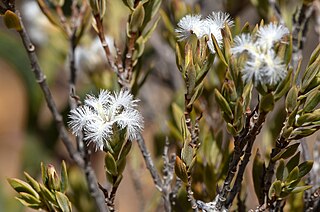
Leucopogon foliosus is a species of flowering plant in the heath family Ericaceae and is endemic to the south-west of Western Australia. It is a low, spreading shrub with hairy young branchlets, spirally arranged, erect, linear, narrowly egg-shaped to narrowly elliptic leaves, and white, narrowly bell-shaped flowers.
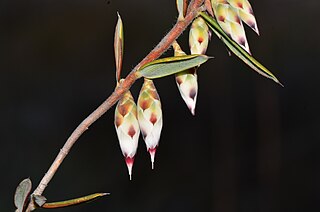
Conostephium hortiorum is a species of flowering plant in the family Ericaceae and is endemic to the south-west of Western Australia. It is a spreading shrub with linear, narrowly elliptic or narrowly triangular sharply-pointed leaves and pendulous, spindle-shaped, straw-coloured and dark purple flowers.
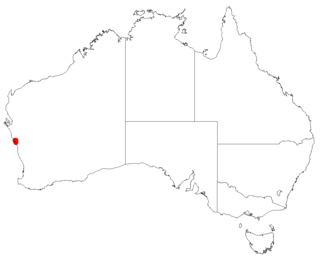
Leucopogon borealis is a species of flowering plant in the heath family Ericaceae and is endemic to a restricted area of the west of Western Australia. It is an erect shrub with hairy young branchlets, linear leaves and white flowers in nine to twenty upper leaf axils.

Leucopogon inflexus is a species of flowering plant in the heath family Ericaceae and is endemic to the south-west of Western Australia. It is an erect, open shrub with more or less glabrous young branchlets, spirally arranged, erect, egg-shaped to more or less round leaves, and white, bell-shaped, densely bearded flowers.
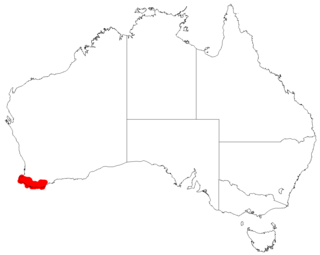
Leucopogon interstans is a species of flowering plant in the heath family Ericaceae and is endemic to the south-west of Western Australia. It is an erect shrub with brownish hairs on its young branchlets, erect, narrowly elliptic or narrowly egg-shaped leaves and white or pinkish flowers in groups in upper leaf axils or on the ends of branches.

Leucopogon microcarpus is a species of flowering plant in the heath family Ericaceae and is endemic to the southwest of Western Australia. It is a low, compact shrub with hairy young branchlets, narrowly elliptic, narrowly egg-shaped or linear leaves and erect, compact clusters of 3 to 9 white, tube-shaped flowers in upper leaf axils or on the ends of branches.
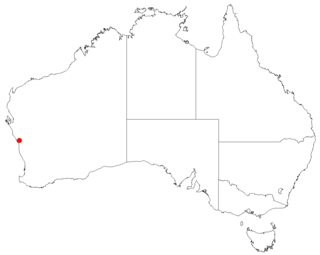
Leucopogon nitidus is a species of flowering plant in the heath family Ericaceae and is endemic to a small area in Western Australia. It is an erect, open shrub with hairy young branchlets, linear or very narrowly elliptic leaves and erect, compact clusters of 3 to 8 white flowers on the ends of branches and in upper leaf axils.
Styphelia cernua is a species of flowering plant in the heath family Ericaceae and is endemic to a small area of Western Australia. It is an erect shrub with narrowly egg-shaped leaves with the narrower end towards the base, and white flowers arranged singly or in pairs in leaf axils.
Styphelia chlorantha is a species of flowering plant in the heath family Ericaceae and is endemic to a small area of Western Australia. It is a low, spreading shrub with erect, narrowly egg-shaped to egg-shaped leaves with the narrower end towards the base, and green, tube-shaped flowers arranged singly in leaf axils.
Brachyloma djerral is a species of flowering plant in the family Ericaceae and is endemic to a small area in the west of Western Australia. It is an erect, compact shrub with narrowly egg-shaped to narrowly elliptic leaves and red, tube-shaped flowers.
Brachyloma pirara is a species of flowering plant in the family Ericaceae and is endemic a restricted area in the west of Western Australia. It is an erect, compact shrub with sharply-pointed, linear to narrowly egg-shaped or narrowly elliptic leaves, and red, tube-shaped flowers.
Styphelia longissima is a species of flowering plant in the heath family Ericaceae and is endemic to a few places in the south-west of Western Australia. It is an erect shrub with hairy young branchlets, stem-clasping, sharply-pointed, narrowly egg-shaped to narrowly elliptic leaves, and white, tube-shaped flowers.
Styphelia quartzitica is a species of flowering plant in the heath family Ericaceae and is endemic to a small area in the south of Western Australia. It is an erect shrub with hairy young branchlets, sharply-pointed, linear or very narrowly egg-shaped leaves, and cream-coloured, tube-shaped flowers.
Styphelia sulcata is a species of flowering plant in the heath family Ericaceae and is endemic to a small area in the south of Western Australia. It is a low, compact shrub with narrowly egg-shaped leaves and white flowers arranged singly in leaf axils.
Andersonia annelsii is a species of flowering plant in the family Ericaceae and is endemic to a restricted part of the southwest of Western Australia. It is a low shrub with egg-shaped to round leaves and white, tube-shaped flowers.
Andersonia barbata is a species of flowering plant in the family Ericaceae and is endemic to the south-west of Western Australia. It is an erect shrub with slightly twisted, lance-shaped leaves, and blue flowers.

Andersonia brevifolia is a species of flowering plant in the family Ericaceae and is endemic to the south-west of Western Australia. It is an erect shrub with egg-shaped leaves and white or pink flowers.
Andersonia carinata is a species of flowering plant in the family Ericaceae and is endemic to the south-west of Western Australia. It is an erect shrub with more or less egg-shaped leaves with a keeled base, and pink, pinkish-white or pinkish-purple flowers.
Andersonia ferricola is a species of flowering plant in the family Ericaceae and is endemic to a restricted part of the southwest of Western Australia. It is a straggling shrub with twisted, narrowly egg-shaped leaves and pale lilac, tube-shaped flowers.








